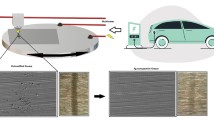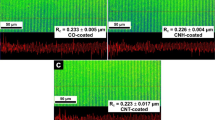Abstract
Electromechanical switches use gold-plated contacts that have an expected life of at least one million switching cycles. However, these contacts often fail prematurely from wear of the gold plating. A film of contact lubricant over thin gold plating is an effective alternative to reduce wear and increase contact life. That was the case for contacts that operated at high contact loads, usually greater than 50 gf, but with the miniaturization of all devices electrical contacts are now being used at loads as low as 5 gf. Use of conventional lubricants, which are organic materials and insulating, can affect the performance of electrical contacts operating at low loads. This paper examines the effect on contact resistance of unlubricated and various commercial lubricant films between gold-plated contacts over the load range of 1–35 gf. It was unexpectedly found that 6 out 10 tested lubricants resulted in increased contact resistance, orders of magnitude higher than the unlubricated contact case, for loads up to 7 gf. A critical load was also found, below which the contact resistance was higher than that for the unlubricated case.













Similar content being viewed by others
References
R. Holm, Electric Contacts: Theory and Application (Springer, Berlin, 1967)
R. Martens, M. Pecht, J. Mater. Sci. 11, 209 (2000)
M. Braunovic, V.V. Komchits, N.K. Myshkin, Electrical Contacts: Fundamentals, Applications and Technology (CRC Press, Boca Raton, 2007)
R.S. Mroczkowski, Electronic Connector Handbook: Theory and Applications (McGraw-Hill, New York, 1998)
M. Antler, Wear 6, 44 (1963)
M. Antler, I.E.E.E. Trans, Compon. Hybrids Manuf. Technol. 10, 32 (1987)
S. Noel, A. Brezard-Oudot, P. Chretien, D. Alamarguy, in 2017 IEEE Holm Conference on Electrical Contact (IEEE, 2017), pp. 109–116
B. H. Chudnovsky, in Proceedings of the Fifty-First IEEE Holm Conference on Electrical Contact (IEEE, 2005), pp. 107–114
W. Campbell, I.E.E.E. Trans, Compon. Hybrids Manuf. Technol. 1, 4 (1978)
F. Ostendorf, T. Wielsch, M. Reiniger, in 2012 IEEE 58th Holm Conference on Electrical Contact (IEEE, 2012), pp. 1–9
O. Graton, S. Fouvry, R. Enquebecq, L. Petit, in 2018 IEEE Holm Conference on Electrical Contact (IEEE, 2018), pp. 426–434
N.K. Myshkin, M. Braunovich, V.V. Konchits, J. Frict. Wear 36, 454 (2015)
R.W. Wilson, Proc. Phys. Soc. Sect. B 68, 625 (1955)
P. Van Dijk, AMP J. Technol. 2, 56 (1992)
T. Tamai, M. Yamakawa, Y. Nakamura, IEICE Trans. Electron. E99.C, 985 (2016)
S. Timsit, in Electrical Contacts: 1998. Proceedings of the Forty-Fourth IEEE Holm Conference on Electrical Contacts (Cat. No.98CB36238) (IEEE, 1998), pp. 1–19
J.A. Williamson, J.B.P. GreenWood, in Electr. Contacts Electromechanical Components Proceedings of the International Conference on Electrical Contacts and Electromechanical Components, Beijing, China (1989)
G. Dorsey, in 2015 IEEE 61st Holm Conference on Electrical Contacts (IEEE, 2015), pp. 63–75
N.K. Myshkin, V.V. Konchits, Wear 172(6), 29–40 (1994)
S.T. Mortier, M. Roy, M.F. Fox, S. Orszulik, Chemistry and Technology of Lubricants (Springer, Dordrecht, 2010)
N.K. Konchits, V.V. Kirpichenko, Y.E. Myshkin, Tribol. Int. 29, 365 (1996)
T. Sakurai, T. Baba, S. Ohara, Bull. Japan Pet. Inst. 1, 23 (1959)
H.W. Fox, E.F. Hare, W.A. Zisman, J. Phys. Chem. 59, 1097 (1955)
R.J. Waltman, Langmuir 20, 3166 (2004)
Acknowledgements
The authors wish to thank the over 100 companies that support the Center for Advanced Life Cycle Engineering (CALCE) at the University of Maryland, and especially the members of the CALCE Electronic Products and Systems Consortium.
Author information
Authors and Affiliations
Corresponding author
Additional information
Publisher's Note
Springer Nature remains neutral with regard to jurisdictional claims in published maps and institutional affiliations.
Rights and permissions
About this article
Cite this article
Kaushik, L., Azarian, M.H. & Pecht, M. Effect of different lubricant films on contact resistance of stationary separable gold-plated electrical contacts. J Mater Sci: Mater Electron 30, 14368–14381 (2019). https://doi.org/10.1007/s10854-019-01806-y
Received:
Accepted:
Published:
Issue Date:
DOI: https://doi.org/10.1007/s10854-019-01806-y




